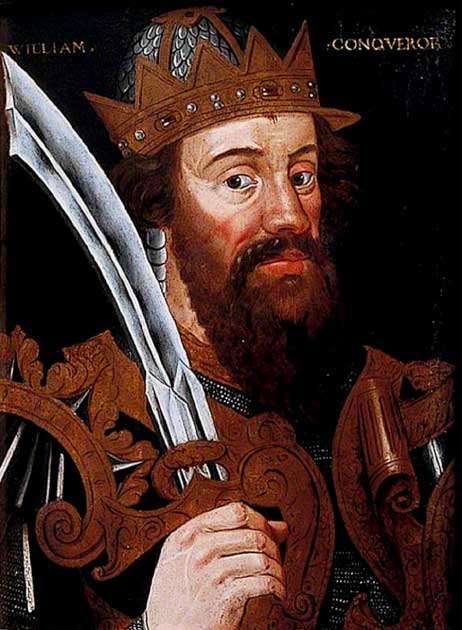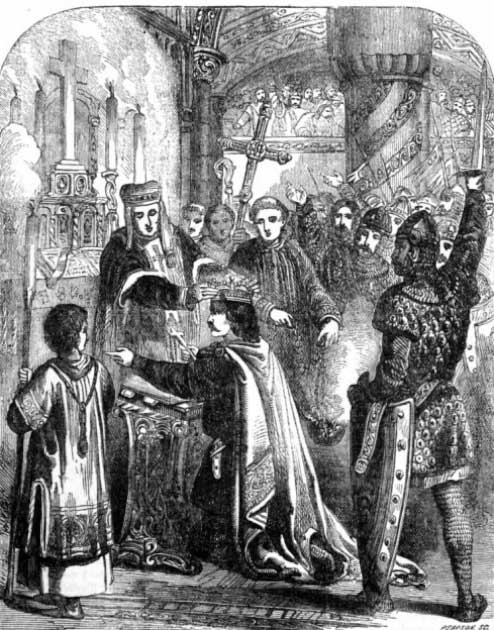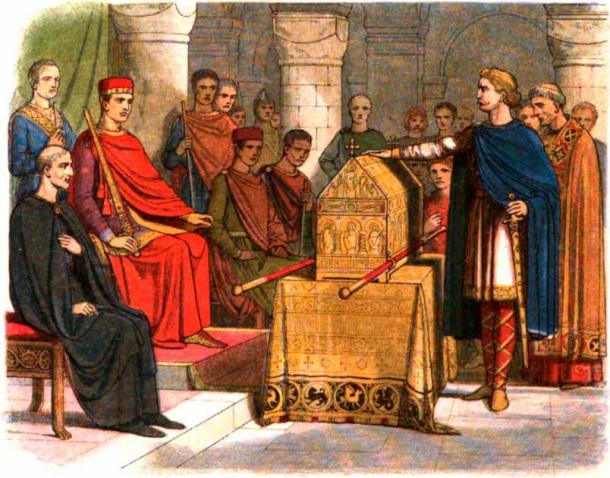
William the Conqueror’s Body Exploded in a Grotesque Shower at Funeral
The first Norman king of England met an untimely and turbulent death, although, to be fair, the situation really ‘exploded’ after his death. William the Conqueror, sometimes known as William the Bastard, and, of course, William I, reigned from 1066 until his death in 1087 while leading a campaign in northern France. It would be fair to say that William ‘the Conqueror’ enjoyed the fruits of his conquests, quite literally. He grew immensely fat, and he died with the pommel of his saddle literally driven into his intestines.

Oil painting of William the Conqueror, circa 1580 (Public Domain)
A Cruel Death, an Exploding Affair
This is not the end of his miserable tale, unfortunately. William the Conqueror died after six weeks of intestinal torture, as the medicine of the time could not help him at all. A man with a fierce temper and no friends, his corpse lay in a surgical facility in Rouen for a few days, before being brought out to be embalmed by a dutiful knight performing his vassalage. Prior to this, the very room where his body lay had been looted inch by inch, including taking away the late king’s clothes and leaving him naked.
“The lesser attendants, seeing that their superiors had absconded, seized the arms, vessels, clothing, linen, and all the royal furnishings, and hurried away leaving the king's body almost naked on the floor of the house," one of the accounts wrote. They left him, "as if he had been a barbarian."
The butchered and decomposed body of William the Conqueror was then sent to Caen, the familial seat. There, a fire broke out in the city, further delaying the funereal process, followed by a land ownership dispute by a man who claimed that the church was built on his ancestral land. The one who had granted the church this land? William the Conqueror himself! Meanwhile, the king’s obese decomposing body, wrapped in funeral sheets, kept bloating up.
It reached such a stage that the gravediggers were unable to fit his body into the hole! As they attempted to literally force his corpse into the grave, his body burst and pieces rained upon the mourners. Naturally, a horribly putrid stench filled the air, leading some people to become sick or pass out. Lots of mourners ran away, traumatized.
One of the accounts states that William the Conqueror’s “swollen bowels burst, and an intolerable stench assailed the nostrils of the by-standers and the whole crowd”. The gravediggers, to their credit, salvaged the situation, taking whatever was left of William’s body, and giving him some sort of burial. An undignified ending for a man unloved even by his own son.
- The Norman Invasion: An Epic 11th Century Battle for the English Throne
- Odo of Bayeux: Sharing the Spoils Under William the Conqueror

Coronation of William the Conqueror (Public Domain)
William the Would-Be Conqueror Lays Claim to the English Throne
On humanitarian grounds, no one should have to suffer such a cruel fate. Yet, tears were not shed at William’s funeral even by most of his family members. What led to such an end for one of history’s most notorious rulers? William’s life started in relative obscurity; his parents were unwed (hence ‘the Bastard’), and his father died when he was eight. He descended on his father’s side from Rollo, the Norwegian Viking, who had received Normandy as a gift from the king of France in return for defending it.
He became the Duke of Normandy as early as 1035, still over three decades away from becoming king. He was not a well-liked ruler, or as effective an administrator as he potentially thought. In fact, Normandy was in disarray, and the citizenry, led by the peasants, were constantly in a state of rebellion. In response, William the (future) Conqueror took to violence; he burned down villages, slaughtered thousands of people, and inflicted further poverty.
William’s ambitions would never let him just be the ‘Duke of Normandy’. His claim to the throne was dubious to begin with, but one he exploited nonetheless. He was the distant cousin of the English king Edward the Confessor. Edward was childless, and in 1051 invited William to his court, allegedly promising him the throne when he died.
What complicated matters for the ambitious William was Edwards’s brother-in-law, Harold Godwinson, whose supporters claimed that the same promise had been made to him. Godwinson was the Earl of Essex, and by some logic, it could be argued, had a more ‘noble’ claim to the throne. Harold therefore ascended to the throne in 1066, although there was a third claimant to the throne - Viking warrior Harald Hardrada, who was related to Cnut the Great.
William dismissed both of these claims without batting an eyelid, particularly the Norwegian, who came from a line of kings who didn’t exist anymore. Harold’s claim was more complicated, because he and William had fought alongside in battle, and William had saved the life of two of Harold’s knights on one occasion. A famous tapestry shows that Harold had pledged the throne to William in 1064, so his claim was not just illegal, but also a breaking of his oath.
Yet, Harold did William a favor that would cost him his life. He defeated Harald Hardrada’s army at Stamford Bridge towards the end of September. According to historical records, William raced to Hastings when he learned that the claimant king’s fleet had reach England’s southern coast. Here, William put an arrow in Harold’s eye, securing his path to the throne.
- The Dramatic History of the Normans: A Tale of Medieval Conquest
- The Rufus Stone: Memorial to William Rufus, Unpopular Norman King of England

Harold Godwinson swears fealty to William the Conqueror, 1864 engraving (Public Domain)
Why William the Conqueror Died Alone
William the Conqueror’s reign was marked by widespread violence, oppression, suppression of the Anglo-Saxon culture and way of life, and frequent slaughter of citizenry. He was known for nit-picking and getting overly involved in the lives of his citizens – by all accounts a control freak.
He was also an incredible glutton; he indulged in the finest foods and imbibed the finest ales. His unquenchable appetite led him to become literally morbidly obese, and this was the ultimate reason for his unfortunate demise. In addition, he had a fearsome temper, and so, he was abandoned in his death by all those who worked for him or were forced to serve him.
There are actually two slightly differing accounts of William’s death. The more famous of the two is in the Historia Ecclesiastica, written by the Benedictine monk and chronicler Orderic Vitalis, who spent his adult life in Saint-Evroult monastery in Normandy. It was another contemporary, William of Malmesbury, who pointed out that the wooden pommels of medieval saddles were high and hard, often reinforced with metal. Such a pommel punctured the unfortunate king’s intestines.
Before dying, William the Conqueror left a confusing will, which handed over kingship to his younger son, William Rufus. Although this was technically in keeping with Norman tradition, William Senior did not split his dominions in a coherent and effective manner. Rufus’ coronation was a bit of a joke, with his father’s funeral proceedings the only thing that covered up the farce. William the Conqueror’s estate and legacy would leave generations of his family squabbling with each other, marking the end of a man who came into this world violently, lived even worse, and died in true disrepute.
Finally, he never even got to rest in peace. His grave was disturbed three times. First, by the Catholic Church when he was reinterred, then at the hands of Calvinists, and finally during the French Revolution. His bones were scattered far and wide, except his thigh bone. A stone slab has been erected to mark the few remains of England’s first Norman king.
Top image: Splat pattern. Source: Ruslan Gilmanshin / Adobe Stock
By Sahir Pandey
References
Bibby, M. William the Conqueror’s Exploding Corpse. Available at: https://www.historic-uk.com/HistoryUK/HistoryofEngland/William-The-Conqueror-Exploding-Corpse/.
Felton, J. 2022. Exploding Casket Syndrome and the King Who Burst Over His Mourners. Available at: https://www.iflscience.com/exploding-casket-syndrome-and-the-king-who-burst-over-his-mourners-63207.
Gaskill, M. 2018. The Final Humiliation of William the Conqueror’s Body During his Funeral. Available at: https://www.thevintagenews.com/2018/12/01/william-the-conqueror/?chrome=1.
Langston, B. 2022. The Lingering Death and Botched Burial of William the Conqueror. Available at: https://owlcation.com/humanities/The-Lingering-Death-and-Botched-Burial-of-William-the-Conqueror.
Serena, K. 2019. Gross! William the Conqueror’s Corpse Exploded on People at His Funeral. Available at: https://allthatsinteresting.com/william-the-conqueror.
Stilo, A. N.D. The Death of William the Conqueror. Available at: https://penelope.uchicago.edu/~grout/encyclopaedia_romana/britannia/anglo-saxon/hastings/williamdeath.html.
The British King Whose Corpse Exploded During His Funeral. 2017. Mental Floss. Available at: https://www.mentalfloss.com/article/90921/british-king-whose-corpse-exploded-during-his-funeral.
















Comments
A fitting end for a tyrant, not so fearsome in death.
Enjoy your 'facts'. They would go down a treat at a quiz night. Those behind the brainwashing love quizzes. It's a way of getting the brainwashed to think they're in charge of their own faculties when they have as much to do with thinking as Christ does with the hierarchy of the Anglican Church...
I went to a public garden on Crown land in a city of sin the other day. I saw mosaic pentagrams, sixes galore, tridents and an upside down cross. That's an actual fact.
While most 'stick to facts', others just make them up under the influence of pentagrams, sixes galore, tridents and an upside down cross. The latter do that so that lesser mortals can 'stick to facts' while having needles stuck in them like a voodoo doll.
Anyway, thanks for the reply. I got to read what I wrote again. I don't like getting things wrong and I'm glad to see I didn't. You should try it some time.
Tl;Dr.
I'll stick to facts of the day and age, thanks.
One normally wouldn't answer such replies, when one's political and literary skills are far beyond such dross. However, sometimes one needs to slum it in order to point out that one can not truthfully notice another doing what the other doesn't actually do. One is both allergic to straw and to arguments made of it.
What William the Bastard did was to be a violent Norman French Duke and, most likely, usurp a crown equally violently. One should not provide him a 'free pass', historically. He was a Bastard in more ways than one.
However, none of that excuses the pathetic grovelling during the Jubilee. When the truth outs about the late Philip and his much later uncle Dickie and what Dickie did with his..., and much, much more about The Firm besides, one may find it necessary to hide one's face in shame, or to slink back under one's bridge like a good troll. Except, of course, some of the truth is already out there. Even if one's excuse is ignorance, it can still be rightfully shameful.
By the way, six degrees of separation is often overstated. It can be fewer than that. One may well dwell on that for a bit.
One shouldn't dwell on another's Scottish pen-name, though, if that was the case (notice the "if"?). One's family tree is half English, so one has no axe to grind there. Nor has one hidden one's Colonial status on this site, in the past.
Finally, more open minds will question if what I say is true or if I am crazy. The answer is more complicated. I am crazy and it is true, but I am not as crazy as those who refuse to know the truth.
I hope one had a good Jubilee. If one is to live in ignorance, one may as well enjoy it.
Notice you give the French Normans a free pass of course. They didn't have to wade in, oppress England for hundreds of years and fuel the fire.
Hope you had a lovely Jubilee.
Pages